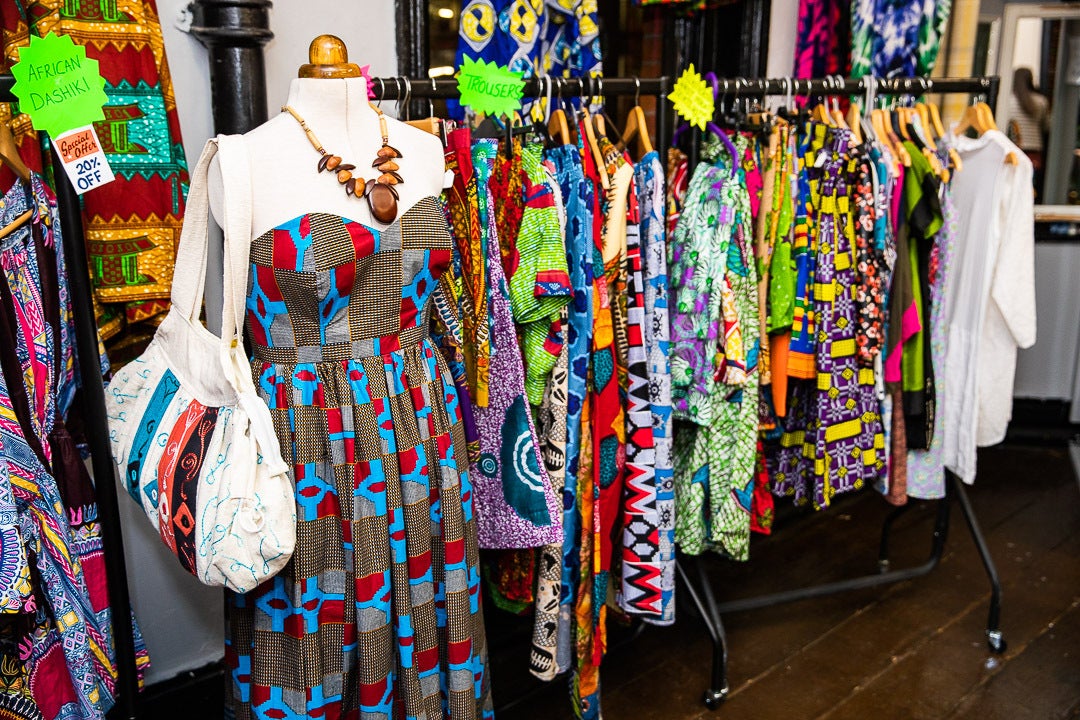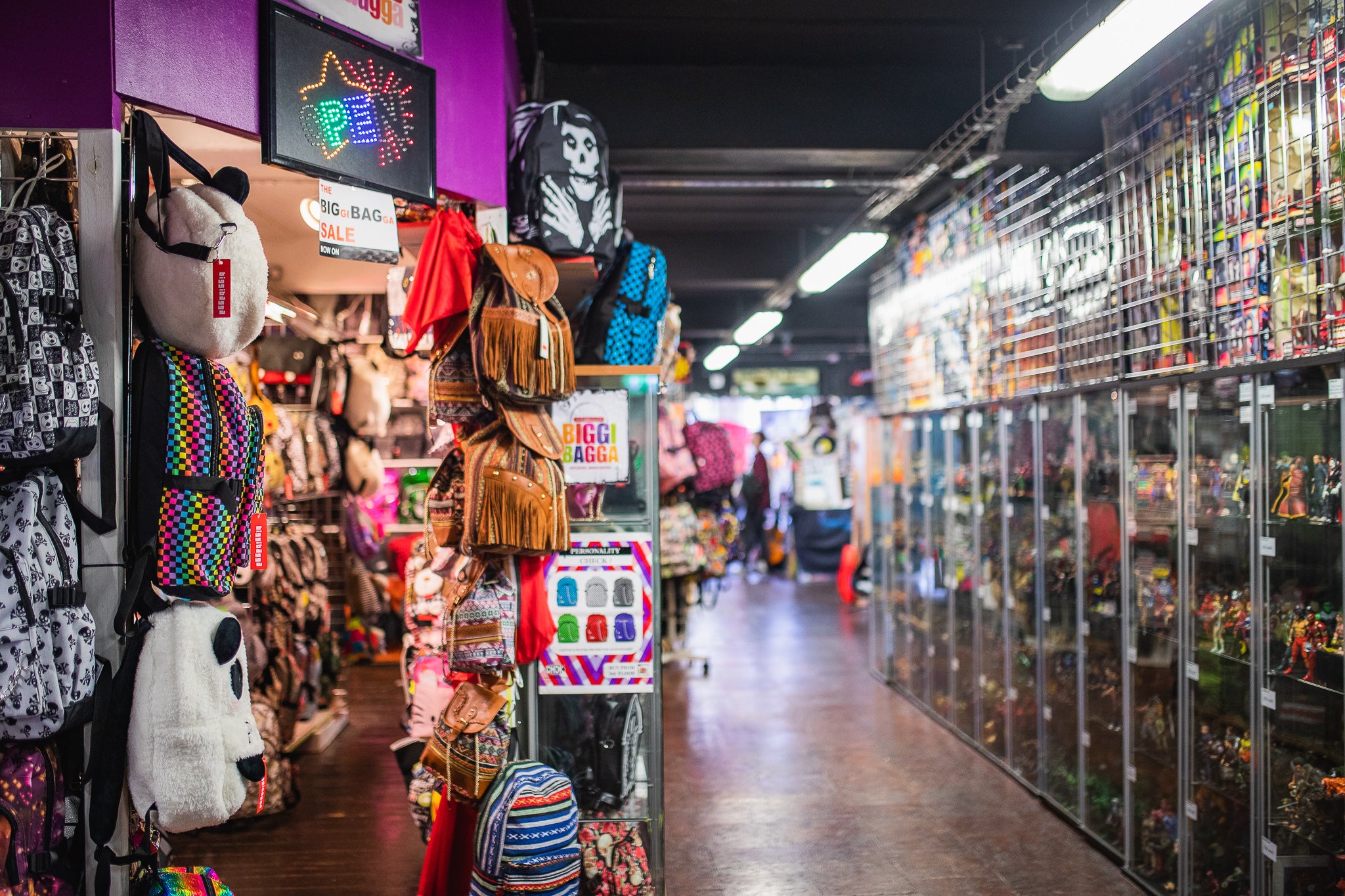‘The secret is it’s always evolving’: How Afflecks became a Manchester institution
Could this 40-year-old indie experiment be the secret to regenerating 21st-century high streets, asks Colin Drury


When Kim Turner was offered the chance to open a stall in a new bazaar being set up in Manchester 40 years ago, he had his doubts.
The then 27-year-old musician had enquired about running a small vintage clothes stand in a city centre arts market. Instead, the owners had told him he could have a spot at their new venture – in a derelict Victorian department store in a part of town, just north of Piccadilly, overrun with petty crime.
“I thought the idea was daft,” he says today. “There was no future there. The council were talking about knocking the whole neighbourhood down. But I only wanted a temporary thing between [playing in] bands so I took it: sell some clobber, make a few quid and get out when it all inevitably went tits-up.”
Today, he is speaking as he sits behind the counter of the shop – Zeffa – he has run there ever since.
In the intervening four decades, the now 67-year-old has found himself a first-hand witness to that bazaar’s transformation into perhaps England’s most legendary – and most eclectic – shopping emporium.
Afflecks (or Afflecks Palace as it was known until 2008) has grown into a four-storey labyrinth of counterculture – part unique retail experience, part arts hub, part safe space from the mainstream.

Here, across 53 independent shops, stalls and cafes that all merge and meld into each other, one can find everything from alternative fashion, indie records and left-field posters to tarot reading, tattoo parlours and piercing shops. It is home to the UK’s biggest pride store; the country’s last remaining cassette shop; and an anime cafe where staff serve bubble tea while dressed in cosplay outfits. Joe Strummer, Debbie Harry and Alice Cooper have all shopped here. Lady Gaga spent £8,000 in a single visit. Afflecks, as the artist Mark Kennedy remarked, has become a home for “individuals, mavericks, freaks [and] people who don’t fit in”.
Yet it is much more than that.
This sprawling cabinet of curiosities attracts more than 1.5 million people through its doors every year. Its growth in the Eighties and Nineties has been credited with sparking the regeneration of Manchester’s now much-eulogised Northern Quarter. So important is Afflecks to the city – both as a cultural totem and an economic driver – that when it was threatened with closure in the late Noughties, the council (the same council that once wanted it demolished) considered taking ownership.
Even a pandemic and the rise of internet shopping have not curbed its popularity. As high street staples have repeatedly failed over the last decade, Afflecks celebrates its 40th anniversary this month apparently stronger than ever.
For urban planners, this raises an irresistible question.
Since 2016, 83 per cent of the UK’s department stores have closed. Vast empty buildings – former BHS, Debenhams and John Lewis behemoths among others – now scar town centres across the UK with no apparent consensus on if or how they can be brought back to life. They sit like massive tombstones to another age. Could the Afflecks model, some wonder, offer a way to repurpose such giants – and breathe vibrancy back into our urban centres?
It was about 25 years ago now that Turner noticed a new phenomenon at Zeffa: more parents coming in with teenagers in tow.
“They’d tell me how they’d shopped here when they were young and they wanted to show their 15-year-old kid the place,” he says. “Buy them their first going-out jacket or whatever.”
It’s about new people coming in with new ideas and new shops, bringing new trends and new customers. It stays relevant because it is so dynamic
Then, earlier this year, something entirely new happened. A regular from the Eighties came in – with their teenage grandson.
“How did that make me feel?” he ponders. “Old. It’s like the first time a kid came in and said they needed something to wear to an Eighties theme party. Most of the Eighties was still the future when we opened.”
It’s easy to see why there is such timeless affection for Afflecks.
Walking inside is to be transported into a more colourful, more characterful and more chaotic world.
To some extent, it defies description. Amid its maze-like interior are clothes, jewellery, fancy dress, make-up, records, military garb, bongs, bags, antiques, toys, tapes, tassels, figurines, vinyl and industrial quantities of glitter. Walls are decked with posters: The Stone Roses and The Smiths, of course, but also George Best, Bob Marley and Emmeline Pankhurst. Spare space is filled with retro arcades or art displays. Visitors are never far from either a rainbow or – this being Manchester – a bee. Outside, on a tiled mosaic is the slogan that has become perhaps this city’s most famed phrase: “On the sixth day God created Manchester.”
“The secret is it’s constantly changing,” says Sean Berry who has run Panic Posters here for 29 years. “It’s always evolving. You have people like me who’ve been here decades providing, I suppose, some continuity but, at its heart, it’s about new people coming in with new ideas and new shops, bringing new trends and new customers. It stays relevant because it is so dynamic.”
The customers here are as unique – and as varied – as the setting.

On a weekend, it can sometimes feel like a teenage hang-out. Claire Kelsey, owner of Ginger’s Comfort Emporium, says – with tongue perhaps only slightly in cheek – that she regrets installing a big booth sofa in her ice cream parlour because youngsters constantly “hide in them and snog”.
Yet, across a week, there are also young professionals in search of bargains, office workers looking for weekend threads and antique shoppers browsing for vintage clothes and knick-knacks. “People have this idea it’s mainly young people and there’s truth in that,” says Berry again. “But, believe me, there’s plenty of grandmas coming in here looking for corsets or getting their belly buttons pierced.”
A former manager, Tony Martin, remembers a suited-and-booted businessman coming in occasionally at lunch times. “He’d sit on the Church Street stairs and put on shiny black stilettoes…then walk round for an hour,” he says. “That’s why I love the place. That man felt he could be himself without judgement.”
Tourists, too, make up a significant presence. They come because the place is so closely associated with Manchester’s legendary music scene. Everyone from Noel Gallagher to Matt Healy is said to have been regulars at some point. Mike Joyce called the place his musical education. Clint Boon put on tea parties here. For Peter Hook, it was where he came as a 12-year-old to try and meet girls.
“That reputation means it’s definitely a bit of a visitor attraction these days,” says Berry. “There’s probably not a week goes by I don’t sell a Stone Roses lemon poster to a kid from Scandinavia.”
Those shoppers, pertinently, do not visit Afflecks in isolation. The vast footfall they have created in this part of Manchester has helped spark the regeneration of this entire swathe of the city.
While the bazaar was opened in a crumbling neighbourhood – one rumour suggests the council had stopped replacing street lights to deter people from going there – the Northern Quarter today glitters with bars, cafes, studios, galleries, arcades, barbers, apartments and office space. It is, unambiguously, Manchester’s most famed neighbourhood – and, these days, has the rents to match.

“It’s too simplistic to say Afflecks alone was responsible for that,” says Dr Steve Millington, director of the Institute of Place Management at Manchester Metropolitan University.
Rather, he reckons, a “perfect alignment of the stars” made the shift possible. Cheap rents, easy access to Piccadilly station and other early pioneers like the Dry Bar (an off-shoot of the Factory nightclub) all helped, he says. The city’s wider redevelopment after the 1996 Arndale bombing also contributed.
“But certainly [Afflecks] was a huge central part of that,” he says. “I don’t think anyone would seriously contest that, without Afflecks, the Northern Quarter would look very different today.”
So, could this 40-year-old indie experiment be the secret to regenerating 21st-century high streets? Could mini Afflecks reappear in empty buildings across the UK?
To answer that, it may first be worth understanding its history. Which begins, depending on your take, either in the 1980s or the mid-19th century. The building was originally the Robert Lomas department store selling Victorians golf capes, mackintoshes, furs and – not actually that dissimilar to today – feather ruffles and undergarments.
Once known for grandeur, it had been derelict and decaying for almost a decade by 1982. So, when husband-and-wife creatives James and Elaine Walsh approached new owners Bruntwood – a then fledgling Manchester property company – with a proposal to create a hippie-style emporium, a deal was struck almost instantly.
Afflecks Palace, named, confusingly, after a department store that had been located across the street, opened that very summer.
Probably not a week goes by I don’t sell a Stone Roses lemon poster to a kid from Scandinavia
“I remember it being drafty,” says Vanessa Cawley, who opened American Graffiti here the same year. “Mind you,” she adds after a pause, “it’s still drafty.” But it was exciting, she says: “everyone here was creative – we were given these small units made of chipboard walls and then it was our job to turn them into something magical.”
Success has not been linear or constant.
The early years were a long struggle. To some degree, the growth of Manchester’s music scene from the mid-1980s onwards may have saved it from an early death. Possibly nowhere in the world has ever sold so many flared jeans or bucket hats. The Identity clothes shop, in particular, grew (in)famous for embodying the wider cultural moment. “The staff and me doing Es in the afternoon, these massive bass beats crashing around us,” recalls owner Leo B Stanley in a new book about the emporium. “Sometimes we couldn’t hear the customers. Taking money for the clothes was a bonus.”
Later, in the Noughties, there was another dip. Amid both falling customer and shop numbers, owner Elaine Walsh (now without her late husband James) decided not to renew her 25-year property lease. Fears grew that owners Bruntwood – by then a vast multimillion-pound property business – would develop the place into flats.
But they did not.
Instead, the company took on the business itself and pledged to run it as the alternative bazaar it had always been.
“I don’t think anyone at Bruntwood thought Afflecks was going to make them huge amounts of money,” says Andrea George, the company’s director of town centre and consumer brands. “That wasn’t the motivation. We’re a Manchester company and we understood how important it was to the city and how it created a sense of destination. Afflecks’ existence benefits everyone who lives, works or runs a business here. Ourselves included.”
Its continuing success, she reckons, has been ensured by two key things.

One is the fact that traders here are charged only a week’s rent at a time and have only a month’s notice period, meaning young entrepreneurs with fresh ideas can come in and try them out without any real financial risk. “The moment they feel things aren’t working, they can walk away without owing anything,” says George. “Although most actually leave for the opposite reason: because they feel we’ve helped them to a point where they perhaps want their own premises.”
And the second reason for its success? The ability to keep attracting teenagers, while retaining their parents (and grandparents).
To some extent, that is a result of deliberate curation. New shop owners are vetoed by site manager AJ Martyn to ensure they fit with the eclecticism. Just last month, he declined a wood carver’s application for a unit. “His stuff was a bit too ‘live, laugh, love’,” he says. “That’s fine. There’s absolutely a place for that. But it’s probably not here.”
Yet the constantly evolving customer base is also a result of something more organic: the sense of community that has grown here. Everyone is made to feel welcome and safe, says Ian Welham, owner of the Gay Pride Shop.
“One of my happiest memories was of a family from Scotland coming in here,” he says. “The daughter had come out to them that week, and the parents had driven her four hours to bring her shopping here as a show of support.”
He thinks about this. “I was almost crying,” he says. “We are a shop, obviously, but I hope we’re much more than that.”
Forty miles across the Pennines in Sheffield, Simon Chadwick, deputy head of Sheffield University’s School of Architecture, is pondering Afflecks. The South Yorkshire city has arguably been hit as hard as anywhere by department store closures. On the main civic square, a five-storey John Lewis stands empty. On the main shopping drag, a large Debenhams is likewise derelict.
The difference between here and a lot of places is that the grade II-listed John Lewis building is actually owned by the council. It means a lively – and meaningful – public debate is currently raging about how to repurpose it. One proposed design by city architect Adam Park shows retail, cafes and cultural space all overlapping inside. There may be no goth kids or grandmas in corsets in the plans but the similarities with Afflecks are unmistakable.
I’ve always been surprised there aren’t more places like this. It works for everyone: the shop owners, the customers, the city
“You look at Afflecks and it’s absolutely unique,” says Chadwick, who has organised public meetings about Sheffield’s John Lewis. “I don’t think we can recreate that same thing here because it’s such a unique combination of factors that have meant it thrives in Manchester.
“But that model of preserving an iconic building by turning it into a multi-use, multi-purpose destination – that’s exactly how we need to be approaching empty department stores. They can’t just be turned into offices or have one retail giant occupying it all because if that one thing fails you’re left with an empty hole in your town again. We need to be using them as assets to drive footfall into surrounding neighbourhoods.”
For Dr Millington – he from Manchester’s Institute of Place Management – this is exactly right.
Retaining these buildings means not only saving historic civic jewels but also reducing the massive climate footprint of knocking down and rebuilding, he reckons. By then sub-dividing them and making them accessible to young local start-ups, it creates an energy that has been disappearing from urban centres for decades.
“We’ve done some research about what drives the vitality and viability of the high street,” he says. “And one of the key barriers to change is barriers to entry businesses. If you’re a young entrepreneur, how on earth can you afford the commercial rents that have been driven up by major retailers? So multifunctional city centre markets like Afflecks are a really good way of getting those businesses back into town centres and making a virtue of their unique and diverse offering… They can make town centres exciting again.”
Back at Zeffa, Kim Turner considers all this.
“I’ve always been surprised there aren’t more places like this,” he says. “It works for everyone: the shop owners, the customers, the city. But being unique? That’s fine by me.”
He himself has had many a happy memory down the years but perhaps none more than when the English singer Arthur Brown came into his store some years ago.
“The God of Hellfire right here,” he remembers today. “He was off on tour to America and bought a load of stuff. I’ve had a few celebs in here and I never ask for a picture because that’s not cool. But with him, I was tempted. Then, he turns around and goes, ‘Fantastic place, can I get a photo?’ That’s Afflecks. Even the God of Hellfire wanted his picture here.”






Join our commenting forum
Join thought-provoking conversations, follow other Independent readers and see their replies
0Comments